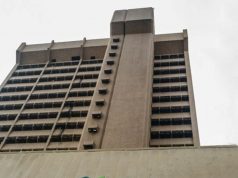SAT, JULY 25 2020-theG&BJournal– Trading in the top three equities FBN Holdings Plc, UACN Plc and United Bank for Africa Plc. accounted for 434.502 million shares worth N2.408 billion in 2,270 deals, contributing 32.18% and 16.68% to the total equity turnover volume and value respectively during the week at the Nigerian Stock Exchange (NSE).
Total turnover of 1.350 billion shares valued at N14.433 billion in 16,723 deals were traded overall as All-Share Index advanced by 0.6% w/w, to 24,427.73 points, also supported by gains in MTNN (+1.7%) and STANBIC (+3.5%).
Month-to-Date and Year-to-Date losses moderated to -0.2% and -9.0%, respectively.
The Oil & Gas (4.7%) index led the losses, followed by the Insurance (-0.8%), Banking (-0.6%) and Consumer Goods (-0.4%) indices. The Industrial Goods (+0.6%) index was the sole gainer for the week.
The Financial Services industry-measured by volume- led the activity chart with 847.677 million shares valued at N5.649 billion traded in 9,068 deals, contributing 62.77% and 39.14% to the total equity turnover volume and value respectively.
The Conglomerates industry followed with 176.425 million shares worth N821.337 million in 400 deals. The Consumer Goods industry recorded a turnover of 158.022 million shares worth N3.768 billion in 2,563 deals.
Analysts still favour cautious trading on COVID-19 related risks and advise investors to seek trading opportunities in only fundamentally justified stocks.
Money market
The overnight (OVN) rate plunged 19.5ppts to 2.2% as inflows from FAAC disbursements to state and local governments (NGN430.03 billion), FGN bond coupon payments (NGN94.42 billion) and OMO maturities (NGN25.36 billion) boosted system liquidity, and outweighed outflows for FGN bond auction debits (NGN178.52 billion).
We expect an expansion in the OVN next week, as expected inflows from FGN bond coupon payments (NGN49.61 billion) may not be sufficient to support liquidity, especially if the conducts an OMO auction.
Treasury bills
Trading activities picked up in the Treasury bills secondary market, on the back of the healthy liquidity in the system. Thus, the average yield across all instruments contracted by 68bps to 4.0%. The overall market was majorly impacted by the OMO segment (-96bps to 4.6%), as reduced funding pressures for local banks buoyed participation, amid weak participation from FPIs. At the NTB segment (-17bps to 1.8%), retail demand continues to support activities despite the abysmal yield in the space.
In the coming week, the expected strain in system liquidity should impede the demand for instruments in the space. At the NTB segment, we expect market participants to switch focus to the primary market where the CBN will be rolling over maturing bills worth NGN256.95 billion.
Bonds
Trading in Treasury bonds secondary market was bullish, as investors re-invested maturities and coupon payments, and looked to cover lost bids at the PMA. Thus, the average yield contracted by 50bps to 7.3%. At the PMA, the DMO offered instruments worth NGN130.00 billion to investors through three re-openings – 12.50% JAN 2026 (Bid-to-offer: 2.9x; Stop rate: 6.00%), 12.50% MAR 2035 (Bid-to-offer: 1.7x; Stop rate: 9.50%) and 12.98% MAR 2050 (Bid-to-offer: 5.9x; Stop rate: 9.95%) –, and a new issue – 9.80% MAR 2050 (Bid-to-offer: 3.7x; Stop rate: 9.80%) –, which has the second-lowest coupon rate in the Treasury bonds market. Despite a total subscription of NGN470.13 billion, the DMO eventually allotted instruments worth NGN177.00 billion, resulting in a bid-cover ratio of 2.7x.
Next week, we expect investors in the Treasury bonds market to continue to cherry-pick due to the relatively attractive yields in the space.
Foreign exchange
The CBN’s foreign reserves sustained its descent as FX outflows continue to outpace inflows, thus dipping by USD86.69 million w/w to USD36.00 billion. Nonetheless, the naira weakened against the US dollar by 0.3% w/w to NGN389.50/USD at the I&E window, and by 0.4% to NGN472.00/USD at the parallel market.
In the forwards market, the naira weakened against the US dollar across the 1-month (-0.3% to NGN391.38/USD), 3-month (-0.4% to NGN395.16/USD), 6-month (-0.6% to NGN400.14/USD) and 1-year (-1.1% to NGN418.10/USD) contracts.
Despite the CBN’s stronger commitment towards exchange rate unification, we still see legroom for the currency to depreciate further, at least towards its REER derived fair value.
Our prognosis is hinged on (1) the widening current account (CA) position, (2) currency mispricing, which could induce speculative attacks on the naira, and (3) the resumption of FX sales to the BDC segment of the market which should place an additional layer of pressure on the reserves as the CBN funds the backlog of unmet FX demand.
Meanwhile, Nigerian banks are restructuring 41% of their total outstanding loans (H1-20: NGN18.90 trillion), which represents NGN7.80 trillion granted to 35,640 clients across the economy, and will allow the banks to change the terms of such loans without classifying them as non-performing.
This comes at a time when the COVID-19 pandemic has brought credit challenges to major sectors of the Nigerian economy, thus exposing the banks to increasing NPLs. particularly in the oil & gas, hospitality, and manufacturing sectors. We see this as positive for the banks, as it gives them ample time to recover their funds without necessarily affecting bottom line as well as Capital Adequacy Ratio (CAR). We note, however, that this will enable banks to keep their cost of funds at low levels thereby reducing the real value of money for the fund providers.-With Cordros Research
|twitter:@theGBJournal|email: info@govandbusinessjournal.com.ng|
Home Companies&Markets Weekly Markets Wrap: Bonds average yield contracts 50bps to 7.3%, ASI advance...









